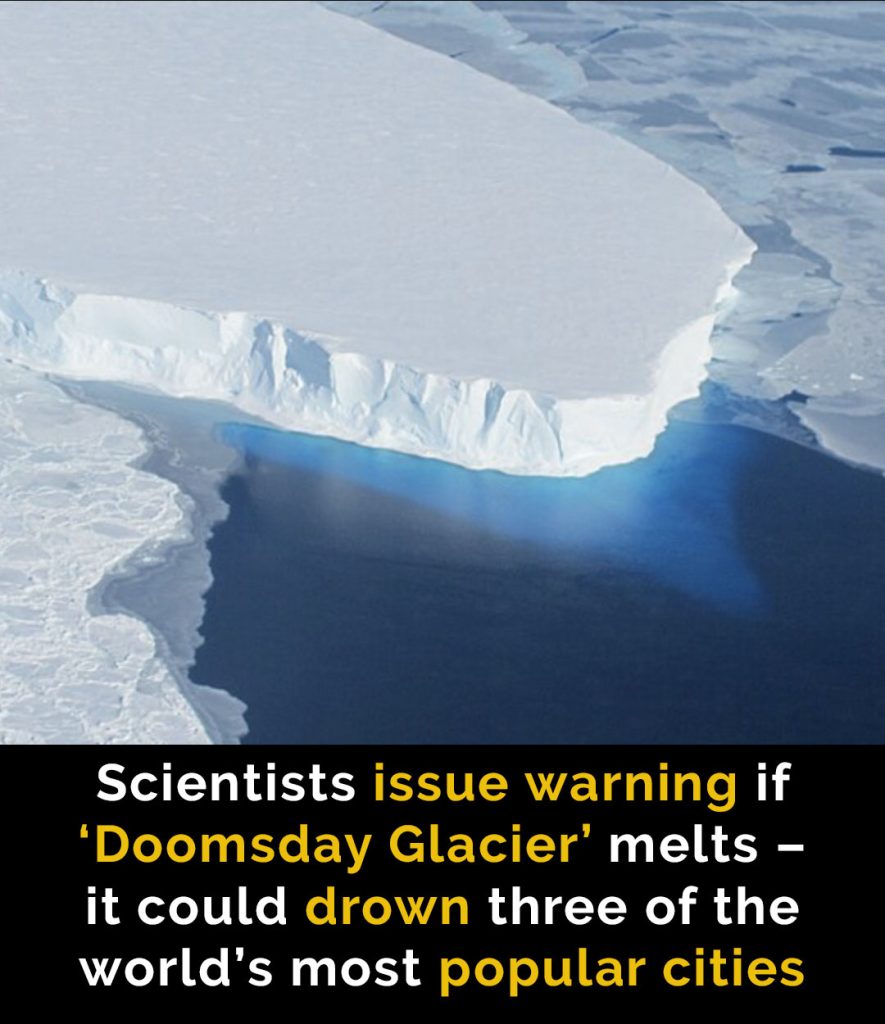Scientists are sounding the alarm on a looming global disaster that could reshape our planet’s coastlines forever. Three of the world’s most famous cities are at risk of being swallowed by the sea if a massive Antarctic glacier known as the “Doomsday Glacier” collapses. Recent research reveals that this nightmare scenario is becoming increasingly likely, with new data showing the glacier’s condition is worsening at a faster pace than many had predicted.

For years, climate change has been associated with rising sea levels, warmer temperatures across the globe, and more frequent extreme weather events. But the latest studies focusing on the Thwaites Glacier—a colossal ice formation in Antarctica ominously nicknamed the Doomsday Glacier—have brought the potential consequences into even sharper focus. A recent report by BBC Science Focus underscores just how serious the situation has become, leaving scientists around the world deeply concerned.
The Thwaites Glacier is situated in West Antarctica, and its sheer size is staggering. It contains enough ice to raise global sea levels by more than two feet on its own. However, experts warn that if Thwaites collapses entirely, the repercussions will not end there. The glacier’s failure could destabilize the much larger Antarctic ice sheet, leading to a devastating domino effect. This catastrophic chain reaction could trigger sea levels to rise by up to ten feet worldwide. That’s enough to submerge low-lying major cities like London, New York City, and Bangkok.
These urban areas are more than just population hubs—they are economic powerhouses and international tourist magnets. Each of these cities is home to millions of residents, and if such severe flooding occurs, they would be among the first to suffer catastrophic destruction. The idea of entire neighborhoods vanishing underwater is no longer confined to Hollywood disaster movies. Scientists are warning it could become a grim reality within our lifetimes if global temperatures continue to climb unchecked.
In response to growing concerns, the International Thwaites Glacier Collaboration (ITGC) was established in 2018. This scientific partnership involves experts from around the world who have been carefully monitoring the glacier’s stability. Their findings are troubling. One of the most alarming discoveries has been the presence of “hidden lakes” underneath the glacier’s surface. These subglacial lakes are believed to play a much larger role in hastening the glacier’s collapse than previously thought.
Professor Noel Gourmelen, a prominent researcher with the ITGC, led a groundbreaking study published in March 2025 that shed light on the troubling influence of these hidden lakes. His team confirmed that the lakes beneath Thwaites are not just minor features—they are actively contributing to rapid ice loss. “We had anticipated that water flowing beneath the ice sheet would have some impact on ocean melting,” Gourmelen said. “But the sheer scale of water drainage we observed took us by surprise. It allowed us to finally measure the significant influence this drainage has on the glacier’s retreat.”
He went on to explain that the lake outflow occurred in a strategically critical area of Thwaites, directly affecting its overall stability. This drainage essentially acted as a ‘turbo boost’ that sped up the glacier’s retreat toward the ocean, making the already dire situation even worse.
This accelerated melting is happening at a time when temperatures in the Southern Hemisphere are reaching unprecedented highs in 2025. This concerning trend indicates that the glacier could be disintegrating much faster than scientists had initially projected. Marine geologist Dr. Alastair Graham from the University of South Florida, who is also part of the ITGC, explained to News.com.au just how much is at stake. “If Thwaites Glacier collapses entirely, we could see sea levels rise by approximately 65 centimeters, or about 25 inches,” Graham stated. “This year has been unlike any other. The conditions we are seeing now are something we haven’t witnessed before. It’s extremely difficult for the glacier to recover from this in just one season. We’re facing a whole new reality.”
While some scientists have estimated that a complete collapse of Thwaites could be decades or even centuries away, the most recent data suggests that the tipping point might be much closer than anyone had hoped. This means that the world could face severe consequences far sooner than expected. A sudden or rapid disintegration of Thwaites would send shockwaves across the globe, causing coastlines to shift dramatically and putting millions of people’s lives, homes, and livelihoods at risk.
Moreover, the economic impact would be colossal. Cities like New York and London are not just residential areas—they are financial and cultural epicenters. Rising sea levels would lead to mass displacement, destruction of infrastructure, and billions of dollars in damages. The cost of protecting these cities, if protection is even possible, would be astronomical.
The potential collapse of Thwaites also poses a significant risk to global supply chains. Ports and transportation hubs located along coastlines would be vulnerable to severe flooding, disrupting the flow of goods and crippling international trade. With global economies already interconnected, the ripple effects could be felt in every corner of the world, from small island nations to industrial giants.
In the face of these warnings, scientists stress that urgent action is needed to curb greenhouse gas emissions and slow the planet’s warming. The clock is ticking, and the choices made today will determine the fate of future generations. While the full collapse of Thwaites may not happen tomorrow, the mounting evidence makes it clear that we are heading toward a critical turning point. It’s no longer a distant problem—it’s a rapidly approaching crisis that demands immediate and sustained action from leaders around the globe.





